Part I: The Arabs: Their History and Heritage
Chapter 2: Development of the Egyptian Region
Five thousand years before Christ, when the Phoenicians were mapping their sea routes, and the Amorites of Northern Syria and the Semites of Palestine were populating Al-Mashraq, the Arab East, the people of one of the countries of the Nile had already introduced into their economic and social lives a solar calendar of three hundred and sixty-five days.
Kemet,[1] the black land, Egypt, which was also called the gift of the Nile, had a civilization and culture that was contemporary with that of the Arab East, and commerce, cultural exchange and political rivalry was already practiced between the two regions.
The Egyptians were a mixture of several stocks ascribed to the Mediterranean races. Their language was related to the Semitic and the Berber, with some traces of the Galla and Somali dialects.
Agriculture was the foundation of the economic life of Egypt, its fertility depending upon the overflowing of the river, from June to October. Today, the High Dam at Aswan relieves some of the agriculture problems faced by the ancient Egyptians, but even in the present day the natural characteristics of the terrain allow Egypt only about thirteen thousand square miles of arable land. To survive, the ancient Egyptians were compelled to devise intricate methods of irrigating the land on the banks of the Nile by using the river’s overflow.
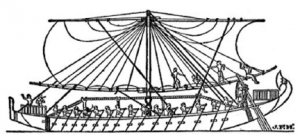
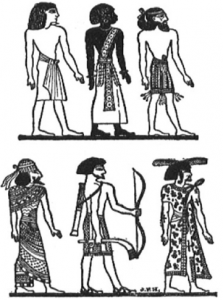
Into this Valley of the Nile, the Egyptians brought an ancient glory whose magnificence is discovered and re-discovered each day in modern Egypt. The temples, palaces and exquisite treasures left by a series of ancient dynasties testify to a civilization, which, with China, is the oldest continuous one in history.
The Pharaohs ruled through an elaborate bureaucracy and their reigns were recorded in 280 B.C. by Manethos, a priest, as encompassing thirty dynasties. During these centuries of grandeur, architects designed colossal pyramids, among them one of the great wonders of the world, the Pyramid of Cheops, built during the Old Kingdom. Majestic buildings of marble and granite were built in the Valley of the Kings, at Luxor, Memphis, and Thebes, buildings rich with sculpture and elaborately painted with figures of gods, humans, and animals. The brilliance and light of these paintings remain fresh as archeologists continue to unearth them from the sands of Egypt.
With their furniture, statuary, painting, art objects, jewelry, food and drink, and a boat to carry them through the heavens in the afterlife, kings and nobles were buried in splendor in the pyramids. These monuments were of such great proportions that scientists and archeologists cannot agree on how these feats of architecture and scientific reckoning were accomplished. It is true, however, that as the dynasties progressed, architecture flourished, industrial crafts reached near perfection, the plastic arts were developed, and mining operations were carried out in the Sinai. Hydraulic works were established in the Fayoum (Lake Moeris), and a great group of palaces known as the Labyrinth were built here as well.
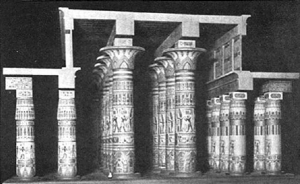

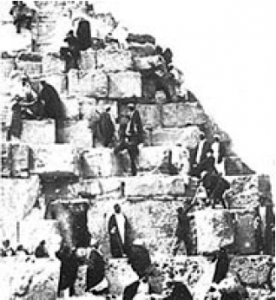
During a period of foreign domination, the Hyksos, a mixed people of Semitic and Hurrian origin from Palestine and Syria introduced the horse into Egypt. From 1520 to 1480 B.C., a woman ruled Egypt.
She was Hatshepsut, the half sister and wife, first of Thutmosis II and later of Thutmosis III. Hatshepsut was an early feminist. She was strong willed, high spirited and determined to reign equally with, or if she could achieve it, above her husbands. For her the title of queen smacked of consort and she called herself Pharaoh, often wearing an artificial beard into the halls of power. The world is reminded of her in the Temple she built at Luxor, “Der El Bahari.”
Monotheism had an early beginning in Egypt. It was first taught and practiced by Amenophis IV who was also known as Ikhanaton. He envisioned a single God for the whole world and saw Him in the sun and its life-giving rays. His wife was Nefertiti, she of the perfect head and profile, whose bust of painted limestone is preserved in the Berlin Museum. Theirs was a short reign of refinement, of peace through diplomacy, of patronage of the arts and education. Ikhanaton’s mother was black and the figures of Ikhanaton show him to be more Nubean and broader featured than Nefertiti. A Sculpted head has been found of a little princess whom legend identifies as their daughter. Held by a regal, slim neck, this head is black, small and proud. While not as widely known as her mother, the little princess, who became one of the black queens of Egypt, is as graceful and beautiful.
While the Pharaohs built temples, palaces and pyramids, fought wars and practiced politics, other men engaged in humbler pursuits. They planted corn and cotton, farmed the delta of the Nile, furthered the sciences and practiced the healing arts. At the same time, they were highly skilled in medicine, both in the art of herbal treatment and in surgery. Archeological evidence indicates that the surgeons were familiar with the techniques of brain surgery.
Other Egyptians followed the stars as the Phoenicians were doing. While they built large ships of cedar imported from Lebanon, they also fashioned smaller boats of papyrus reed, that versatile plant that was pliable enough for manuscripts, yet tough enough to float on unpredictable rivers. How far did these papyrus boats go? Did they merely run errands up and down the Nile, to Memphis, to Thebes, or did they follow all of the great river’s nearly four thousand miles, into the Blue Nile, the Black Nile, to Sudan and Ethiopia? Did they visit strange ports, and sail on into strange seas? Did they find their way, as other ancients may have done, into the great Atlantic in their little paper boats? Some years ago, Thor Heyerdahl built such a boat, christened it Ra, meaning the Sun God, and set out to prove it could be done. Heyerdahl’s voyage demonstrated that early Egyptians could have migrated to Central and South America.
If the Egyptians had come to the New World, was it already peopled, or was it a virgin land in which these sailors settled to become the indigenous population? Who are the Incas, the Aztecs, the American Indians? Where did these ruddy skinned, aquiline featured, long limbed people come from? Are the similarities in art merely an accident of human creativity? There is a striking likeness between ancient Egyptian weaving and a Navajo rug or blanket. The same symbols are found on ancient and new Egyptian arm bracelets and on silver Mexican jewelry. A figure resembling the Egyptian obelisk is prominent in new world metal-craft and embroidery. Is that strong, bird-like figure in North American Indian art the North American Eagle, or Horus, the god of the kings, Horus the Hawk from Egyptian lore?

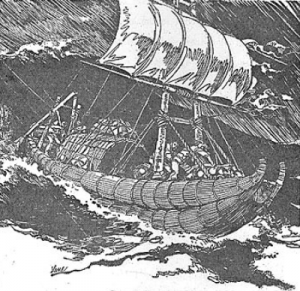
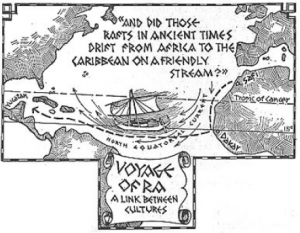
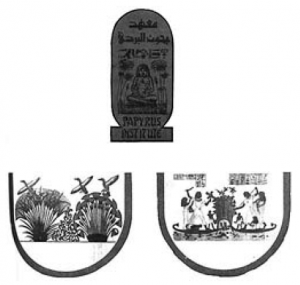
- Brochure, Ministry of Tourism, Government of Egypt, 1970. ↵
